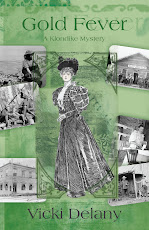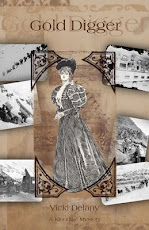
In my research on the North-West Mounted Police for the Klondike Gold Rush series, I recently bought an out of print book titled Dickens of the Mounted by Eric Nicol (who sadly passed away recently at the age of 91). The book is fiction, but based on fact. Francis Dickens, son of Charles, was an Inspector in the NWMP for twelve years. Francis himself died in 1886 just a short while after leaving the police.
The book is very Flashman-esque. It takes what little is known about the real life of Dickens and proposes to be a book of letters he wrote back to England during his time in the NWMP.
His career was, shall we say, less than stellar and apparently his lasting contribution to Canadian history was that from then on the officer corps of the NWMP showed a ‘growing antipathy… towards Englishmen.’
The book is hilarious in places, poignant in others (Francis lived in his father’s shadow his entire life) and most importantly, in my opinion, a darn good historical read.
Francis Dickens joined the NWMP in 1874 (he secured his position as a Sub-Inspector through family connections while still in England – he had never been a police officer). He was slightly too late to take part in the Great March West which left in July. Dickens followed by train. There being at the time no Canadian train route, he had to go through the U.S. to St. Paul and then by stagecoach to Winnipeg.
The March West of the NWMP is one of the key pivotal points in the creation of Canada west of Winnipeg and in the creation of the Canadian identity (the police were sent to bring law and government to Indian lands, not the Army.) It is, naturally, almost completely unknown to any but the keenest follower of Canadian history.
Although Francis Dickens was too late for the March, he soon caught up and spent the remainder of his career in such outposts as Fort Pitt, Fort Walsh, and Fort MacLeod. (In Alberta, where I visited the historical NWMP fort ). He was there for treaty negotiations with the Blackfoot, dealings with Sitting Bull after he and his people came to Canada following the Little Big Horn, met Louis Riel, and fought the rebels in the North West Rebellion.

In the book, he meets and comments on Sam Steele, James Walsh, Sitting Bull, Louis Riel and many other historic characters. Sam Steele, incidentally, was an important player in the Klondike Gold Rush being the NWMP commissioner at that time. One of the towering figures of Canadian history, he is (of course) almost completely unknown.
A laugh out loud incident happens in the book when Dickens meets the Governor General (and son-in-law of Queen Victoria) and the GG wants to speak to him privately once he realizes Francis is the son of Charles Dickens.
“I wonder, Inspector Dickens, whether you can recommend a good publisher back home?”
“A publisher, Your Excellency?”
“Yes. You see, I do a bit of writing myself.”
I have long believed that the best way of teaching history is through historical fiction. Most writers of historical fiction work hard to keep the facts accurate and the setting and tone of the times dead on. But they present the history in a lively, exciting fashion, rather than the boring recitation of facts as it’s presented in most schools. If you want to learn more about the beginnings of the NWMP you could do a lot worse than look for a copy of Dickens of the Mounted.

The book cover shown above is an actual photo of Francis Dickens from the Public Archives of Canada. The Indian is Sitting Bull.
P.S. I am a huge Flashman fan, and the cad himself makes a brief appearance in Dickens of the Mounted, shortly after his adventures with Custer.












No comments:
Post a Comment